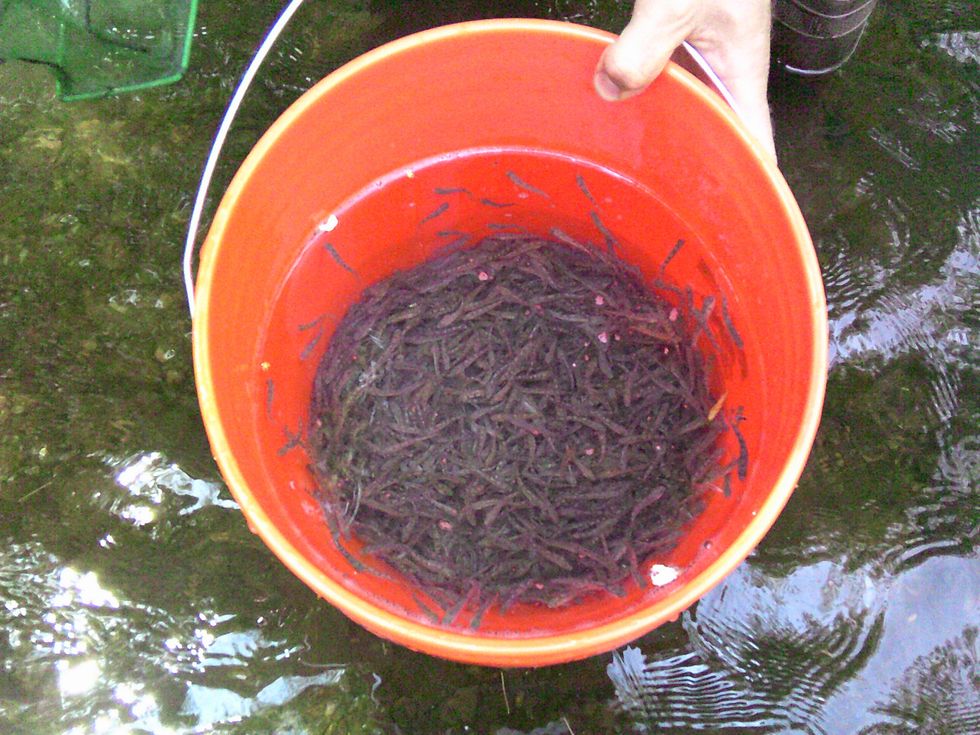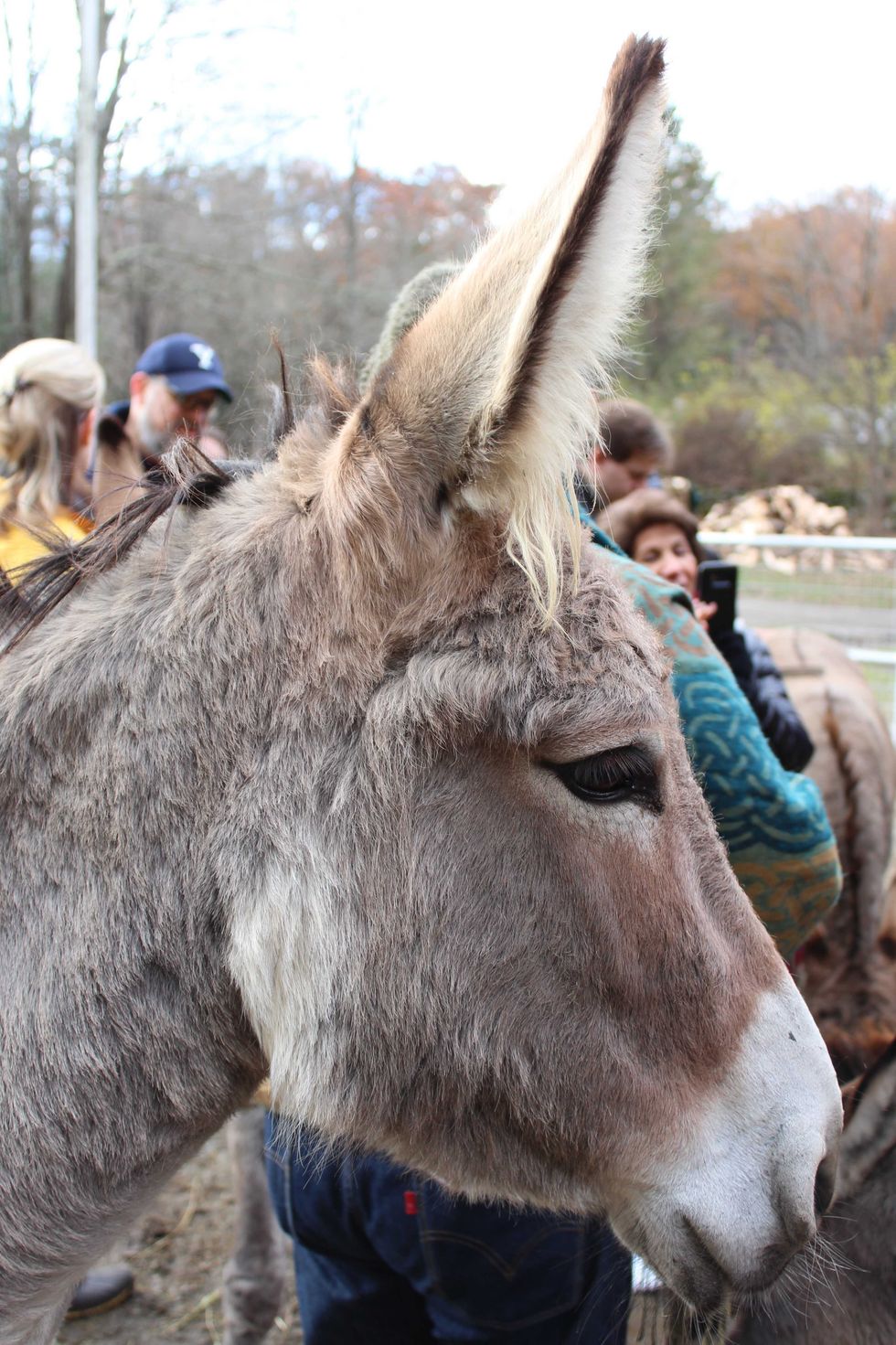Bucket o' fry on the river

Drew Ransom and his able assistant Matt Devine of the state fishery department work in the river.
Patrick L. Sullivan

Drew Ransom and his able assistant Matt Devine of the state fishery department work in the river.
Usually by mid-June I have shifted from tributariessuch as the Blackberry River, Macedonia Brook and Furnace Brook to the Housatonic itself.
But with the wettest May I can recall in the books, and June shaping up to be pretty soggy as well, the Hous has not been at a wading-friendly level in a while.
I’m not saying it can’t be done at 1000 cfs and above. I’m just saying I’m not going to do it.
So I’ve been in the Blackberry a lot. It’s convenient when I only have a couple of hours, and it’s been stocked three times this spring.
And while truck trout are somewhat easier to fool than their wild counterparts, the terrain of the Blackberry -- both in and around the water -- is pretty tricky.
So taken as a whole it’s a suitably challenging prospect.
One fine afternoon I was messing around just upstream of the bridge at Beckley Furnace, trying out a couple of rods I had forgotten about: a Cabelas CGR fiberglass 7.5 foot 5 or 6 weight, and a 6’10” Tenkara rod from Zen Tenkara.
The CGR line of fiberglass rods are a great value in my opinion. I have half a dozen of them, in line weights 2-8. None are longer than 7.5 feet. My favorite is the 6.5 foot 4 weight, an ideal tool for flicking flies at brook trout in close quarters.
(A quick check of the Cabelas website shows they currently only have the 7 foot 5 weight available.)
They list at $79.95, but I got most of mine when they were 50% off.
Which is just insane.
The Zen Tenkara rod is unusual. In the fixed-line world, a 10-footer is a shorty. Under seven feet is rare.
And Karin Miller, the courteous and popular proprietor of Zen Tenkara, specializes in big fish rods. They are sturdy and they are long.
So this model, the Hachi, stands out from the rest of the line.
Both the CGR, which I had rigged with a double tapered #5 line, and the Hachi, which had about 7 feet of #3 fluorocarbon level line plus tippet, are full flex rods. “Wiggly,” for the layman.
I was playing around with a dry-dropper rig on the fly rod and two wet flies and/or small weighted nymphs on the Hachi, and having a good time playing the 12-14 inch fish, mostly rainbows, when I beheld a couple of young men approaching with buckets.
“Dang,” I said. Buckets are never a good sign.
Well, almost never. In this case the bucket brigade was from the state fisheries department in the form of biologist Drew Ransom and his able assistant Matt Devine.
The buckets contained hundreds of brown trout fry, about six months old, that were essentially superfluous to the state hatchery’s requirements.

Ransom said the idea was to plant them in the Blackberry, from Beckley Furnace down to Route 7, and see what happens.
I suggested they would get eaten up pronto by the resident trout and the scientists agreed that was a likely scenario for most of the fry.
But a few might escape that fate and establish themselves.
Devine, eyeing a mini Wooly Bugger in a silvery-grey color I had on my line, opined that the fly would do an admirable job imitating the fry.
I agreed but I didn’t test the theory, at least not then and there. Too close to chumming.
The water temperature that day was 63 degrees and rising, not surprising since it was the middle of a two-day heat wave with air temps cracking 90.
A few days later, and after some additional rain, the water temp had dropped to about 60, but how long that will last is anyone’s guess.
Once water temperatures hit 68 it is time to stop fishing for trout. They have trouble breathing at 68 and above, and even if perfect catch and release practices are followed, they will be severely stressed by the time they are caught, played, netted, admired, had their photograph taken, and returned to the water. They probably won’t make it.
So I’m guessing we’re right about at the end of the practical trout season on the Blackberry until fall, when the water temps will be down again and the state’s stocking trucks return.
If you do go I recommend a dawn raid. The water temperature will be its lowest point and there won’t be anyone else around except fanatics like me.
And I am easily avoided. In fact, like a bear,I will go out of my way to avoid you.
The following information was provided by the Connecticut State Police at Troop B. All suspects are considered innocent until proven guilty in a court of law.
Warrant arrest
On the evening of Dec. 12, troopers arrested Douglas Palmer, 34, of Colebrook on an active arrest warrant relating to an incident that occurred on March 7 on Twin Lakes Road in Salisbury. He was arrested on two counts: “offer to make or make any home improvement without having a current certificate of registration,” and “failure to refund the amount paid for a home improvement within 10 days of a written request.” Palmer was released on a $1,500 non-surety bond and is scheduled to appear at Torrington Superior Court on Dec. 19.
Disturbance yields arrest
On Dec. 13, troopers were dispatched to Locust Avenue in Salisbury on the report of an active disturbance. While investigating, troopers discovered that Tina Humes, 48, of Salisbury had an active warrant out for her arrest for violating probation. Humes was held on a $15,000 cash bond and was transported to Torrington Superior Court for her arraignment on Dec. 15.
Collision with parked vehicle
On the afternoon of Dec. 14, Jeremy Glass, 32, of Suffield, Connecticut was parked on the eastbound shoulder of Cornwall Bridge Road near the intersection with Herrick Road. Michael Fass, 44, of New York City, was traveling east on Cornwall Bridge Road and collided with the rear of delivery Ford Transit T-350 that Glass drove in his leased Hyundai Ioniq 5. All parties were evaluated by Sharon EMS but were found to have no apparent injury. Fass was issued an infraction for distracted driving other than the use of a mobile phone.
Snowy slide-out
Early in the morning on Dec. 14, Nelfy Veizaga Montano was traveling west on Johnson Road in Falls Village on snowy roads when she slid off the roadway while negotiating a downhill curve. She was uninjured in the incident, but her Honda CRV was disabled. She was ultimately issued a written warning for traveling too fast for conditions.
Downtown Lakeville accident
On the afternoon of Dec. 14, Alison Holmes, 25, of Lakeville was driving east on Main Street in Lakeville near the intersection with Bostwick Street when she veered off the road, striking a Department of Transportation-owned bridge. The Subaru Outback she was driving was disabled in the accident, but Holmes reported no injuries. She was issued an infraction for failure to maintain lane.
Car vs. utility pole
Early in the morning on Dec. 15, Enrique Hairol Ramirez Pula, 48, of West Springfield, Massachusetts was driving south on Route 7 near the intersection with Undermountain Road in Falls Village. While attempting to navigate a downhill curve, he drifted across the center line and attempted to recover, subsequently overcorrecting and veering off the roadway, ultimately striking a utility pole. The vehicle was disabled but he was uninjured in the accident, for which he was issued a written warning for failure to maintain lane.
The Lakeville Journal will publish the outcome of police charges. Send mail to P.O. Box 1688, Lakeville, CT 06039, Attn: Police Blotter, or email editor@lakevillejournal.com
Principal Leanne Maguire added a bit of seasonal excitement to the morning drop-off Thursday, Dec. 18, at Cornwall Consolidated School. Dressed as an elf, Maguire was lifted above the school’s front entrance to greet arriving students. The tree bucket was provided by Gervais & Sons Inc.
Keri LaBella of Worcester, Mass., visited the donkeys at Trinity Retreat Center in early December during a women’s retreat.
CORNWALL — On a quiet patch of farmland where West Cornwall’s forested hills roll down toward the Housatonic River, six donkeys lift their heads at the sound of approaching footsteps. Their long ears twitch. Their breaths plume in the frigid air.
The soft brays that greet visitors to Trinity Retreat Center have become part of the landscape here — a warm, familiar sound that carries across the snow-covered fields as December settles in.
The 55-acre spiritual retreat and conference center offers space for rest, reflection and prayer.
For Trinity’s staff, volunteers and the thousands who pass through the retreat center each year, these rescued donkeys have become far more than barn residents guarding the center’s flock of 32 chickens from predators.
They are companions, teachers and symbols of resilience. And at Christmastime, they serve as a living reminder of the season’s most enduring themes: humility, hope and the beauty of second chances.
“The donkeys have an incredible intuition,” said Jason Coppola, director of the retreat center. “They can feel a person’s energy and when they sense people are in need, they tend to gravitate towards them.”
The donkeys, which today live peacefully in West Cornwall, did not begin their lives in such calm surroundings. Their histories, while varied, share a somber thread: all were rescued from kill pens, the last stop for animals before being shipped for slaughter overseas. Donkeys, especially, are at risk because their hides are used to produce a gelatin-based traditional medicine.
Eight years ago, Trinity’s leadership learned that a group of donkeys had been saved from these conditions and were in immediate need of placement. What began as a simple sheltering effort quickly grew into something deeper.
“They arrived frightened, confused and unsure of people,” Joseph Rose, the center’s former co-director who rescued the donkeys, said in an interview conducted shortly after their arrival.
“They had good reason. But one of the most beautiful things has been watching them learn to trust again.”
Some donkeys were severely underweight, including two that were later found to be pregnant. Others arrived with untreated injuries or chronic hoof problems. With patience, veterinary care and daily interaction from staff and volunteers, the animals gradually emerged from their fear.
As the donkeys healed, their presence began to shape the experience of the people who come to the retreat center seeking rest and reflection.
“A lot of our retreatants are generally here to help process through things and try new things,” said Laura Alexander, the retreat center’s facilities and farm manager who has tended to the donkeys since shortly after their arrival.
Today, each donkey — Marge, Lisa, Maggie, Fern, Francine and Buster — has a distinct personality. The gentle one that prefers long quiet walks, the inquisitive one that nudges visitors for scratches, the matriarch that keeps watch over the herd, the youngster that still bounds with playful energy.
On a recent weekday in early November, Keri LaBella of Worcester, Massachusetts, and about two dozen others on a women’s retreat visited the donkeys during early afternoon feeding time as part of the farm tour. As daylight dwindled, she made a solo return,

While stroking the ear of a donkey that had leaned in toward her, LaBella noted that in an era when holiday celebrations can feel rushed and commercialized, this quiet ritual, still, earthy and unadorned, offers something rare: presence. “It’s difficult not to feel something soften inside you.”
She said she feels connected to the donkeys “because they are a lot like me. You really can’t make them do something they don’t think is safe. They’re smart, curious and they love a challenge. And I just love the story of their rescue.”
Visitors of all ages, whether on retreat or neighbors in Cornwall, are invited to join daily donkey care sessions like brushing, walking, offering hay and fresh water and learning the animals’ rescue stories.
“One guest spent all day with the donkeys,” helping with feeding and brushing the animals’ coats, recalled Coppola, who lives on the property a stone’s throw from the barn.
Children visiting from the city, he explained, are so enamored by the experience that many of them return as volunteers.
“It’s wonderful to see the long-lasting impression they have interacting with the donkeys,” said Coppola of the visitors.
For children, meeting the donkeys is often a highlight of their stay.
For adults, the effect can be surprisingly emotional. Some visitors have shared that time with the donkeys helped them through grief, burnout or difficult transitions.
At Trinity, these moments are not separate from the spiritual experience — they are part of it.
‘An amazing 2025’
As of early December, there was no room at the center. Coppola said all 25 guest rooms were booked into the new year.
“It’s been an amazing 2025 and we expect 2026 to be even better. People come here and they leave a different person. It’s incredible what a difference we make in their lives.”
Alexander attributed the global pandemic to a lack of connection, impacting people’s body and soul.“A lot of people come to reconnect with God, themselves and the community. The relationship they have with the donkeys,” she said, “parallels people’s relationships with one another.”
With Christmas’ arrival in the Northwest Corner, the Trinity donkeys stand in their barn, warm against the winter wind, offering, simply by being themselves, a message the season has always shared: peace for the weary, hope for the searching and comfort for every traveler who steps inside.
Cellist Christopher Hoffman wrote and recorded his 13-track, solo record ‘Rex’ while living in the former home of Rex Brasher in Amenia, the self-taught painter who created 1,200+ watercolors of North American birds.
When cellist, composer and filmmaker Christopher Hoffman moved into the former home of Rex Brasher in Amenia in August 2023, he didn’t arrive with a plan to make an album about the painter and ornithologist who once lived there. But once he began to learn about the home’s former inhabitant — about his attention to land, to birds, to work done slowly and with devotion — he started to compose. “Rex,” Hoffman’s solo cello album (releases Jan. 16, 2026) is not a portrait of Brasher so much as an echo of a person, a place and a way of seeing the world.
Brasher (pronounced “brazier”) was born in Brooklyn in 1869, the son of a stockbroker whose passion for birds left a lifelong mark. After his father’s death, Brasher vowed to paint every bird in North America, and to do it from life. He eventually created more than 1,200 works, depicting birds with a precision and intimacy that bordered on obsession. Working largely outside the art world, Brasher lived on 116 wooded acres he called Chickadee Valley, where he painted, wrote and published his monumental 12-volume “Birds and Trees of North America.”

Founded in 2008 to preserve Brasher’s legacy and promote bird and habitat conservation through art, the Rex Brasher Association became an early point of connection for Hoffman, who composed and performed an original piece at the 2023 Rex Brasher Symposium just months after moving into Brasher’s former home. After many years in Brooklyn, Hoffman and his family had been looking for a change when they were shown the 116-acre property by association board member and architect Matthew Schnepf, who shared the history of the land and of Brasher himself.
“We’re the first renters outside of Rex’s family,” Hoffman said, explaining that the house is rented as part of an agreement to maintain the estate. Upon moving in, Hoffman dug deeper, purchasing the two-volume set of “Birds and Trees of North America” and immersing himself in Brasher’s world. Around the same time, and at the encouragement of composer, saxophonist and flutist Henry Threadgill, Hoffman debuted his first solo project at Tomeka Reid’s Chicago Jazz String Summit, planting the seed for the 13-track album that he then composed, recorded, mixed and mastered in Brasher’s home. The RBA (Rex Brasher Association) was equally supportive of the finished work, granting Hoffman permission to use Brasher’s artwork for the album, including the swallow-tailed kite painting that appears on the vinyl packaging. “You open up the record and the whole painting is right there,” said Hoffman.

Though birds are central to the record’s spirit, Hoffman deliberately avoided literal birdsongs. Instead, the cello is layered into dense soundscapes that suggest rather than illustrate. “There are tracks with tons of layered stuff where I guess you could hear bird sounds if you wanted to,” he said. Brasher’s refusal to accept approximation — destroying paintings when feathers didn’t look right — mirrored Hoffman’s own instincts as a musician. Tracks were built, discarded, rebuilt. Nothing stayed unless it felt true.
For Hoffman, “Rex” became a kind of reckoning. Though Hoffman has begun noticing birds with new intensity, using the Merlin bird app to identify some 30 species on the grounds, he says Brasher’s acuity still feels out of reach. “Even with binoculars, I still can’t see the details he was seeing.”
The album will be released Jan. 16 on Out of Your Head Records. Composed for acoustic and electric cello, the record reflects the solitude and intensity that shaped both Brasher’s vision and Hoffman’s process. “This guy was working so hard,” said Hoffman of Brasher. “And it was like, ‘Alright, Chris, get it together. Make the solo record you’re afraid to make.’”
To listen and purchase the album, go to: https://christopherhoffman.bandcamp.com/album/rex